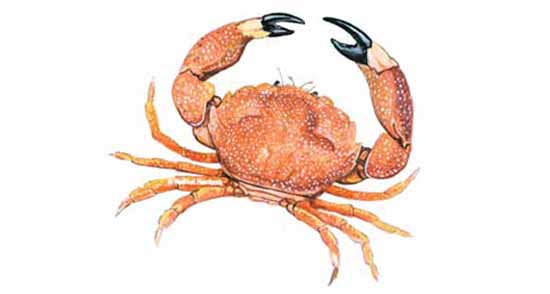Crab, Stone
Published on
January 23, 2014

Florida’s regulatory agencies recognize three species as true stone crabs: the Florida variety (Menippe mercenaria), the Gulf crab (M. adina) and a hybrid resulting from interbreeding of the two primary species. Stone crabs are found along the Atlantic and Gulf coasts from Texas to the Carolinas, but Florida accounts for almost all the commercial harvest. The fishery is unique in that Florida law forbids landing whole stone crabs; only the crab’s large front claws are kept. Fishermen are allowed to take claws with a 2 3/4-inch propodus, which is the pincher section of the claw, measured from the “elbow” joint to the tip of the pincher. After removing the claws, fishermen must return the stone crab safely to the water. If the claws are removed correctly, a thin membrane forms over the wound and prevents bleeding. A legal-sized crab can regenerate a harvestable claw in three annual molts. The crabs are captured commercially with traps, which are rebaited every other day.
Menippe spp.
Stone crab
Florida stone crab, Gulf stone crab
Crabe
Steinkrabbe
Granchio
Kani
Cangrejo
Florida’s regulatory agencies recognize three species as true stone crabs: the Florida variety (Menippe mercenaria), the Gulf crab (M. adina) and a hybrid resulting from interbreeding of the two primary species. Stone crabs are found along the Atlantic and Gulf coasts from Texas to the Carolinas, but Florida accounts for almost all the commercial harvest. The fishery is unique in that Florida law forbids landing whole stone crabs; only the crab’s large front claws are kept. Fishermen are allowed to take claws with a 2 3/4-inch propodus, which is the pincher section of the claw, measured from the “elbow” joint to the tip of the pincher. After removing the claws, fishermen must return the stone crab safely to the water. If the claws are removed correctly, a thin membrane forms over the wound and prevents bleeding. A legal-sized crab can regenerate a harvestable claw in three annual molts. The crabs are captured commercially with traps, which are rebaited every other day.
Stone-crab claws are smooth and rounded. The shells turn bright orange when cooked; the tips remain black. Raw meat is grayish; cooked is white. The meat resembles lobster in appearance.The claw meat is sweet, mild and firm, like a cross between crab and lobster. The shell is “harder than a landlord’s heart,” noted one Florida gourmand.
| Calories: | 71 |
| Fat Calories: | 0 |
| Total Fat: | 0 g |
| Saturated Fat: | 0 g |
| Cholesterol: | 53 mg |
| Sodium: | 353 mg |
| Protein: | 17.6 g |
| Omega 3: | N/A |
Boiling is the best way to prepare stone crab. The rich meat needs only simple treatment. Crack the hard shells with a mallet or nutcracker and serve cold with hot melted butter and a squeeze of lemon. Or serve with lime wedges and mayonnaise or a lime-and-dill vinaigrette. Thaw frozen claws in the refrigerator for 12 to 18 hours. Quality is lost when claws are thawed under cold running water. Never thaw at room temperature.
Lobster, Other crab species
- Bake
- Boil
- Broil
- Fry
- Grill
- Pate
- Poach
- Saute
- Smoke
- Steam
Fresh: Cooked whole claws
Frozen: Cooked whole claws
United States







